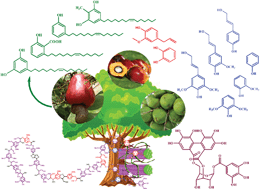Naturally occurring phenolic sources: monomers and polymers
Abstract
Exploration of sustainable alternatives to chemicals derived from petro-based industries is the current challenge for maintaining the balance between the needs of a changing world while preserving nature. The major source for sustainable chemicals is either the natural existing plant sources or waste generated from agro-based industries. The utility of such resources will supplement new processed materials with different sets of properties and environmental friendliness due to their biodegradability and low toxicity during preparation, usage and disposal. Amongst other polymers used on a day-to-day basis, phenolic resins account for vast usage. Replacement of petro-based monomers such as phenol and its derivatives either partly or completely utilized for the synthesis of such resins is ongoing. Extraction of natural phenolic components from cashew nut shell liquid, lignin, tannin, palm oil, coconut shell tar or from agricultural and industrial waste, and their utilization as synthons for the preparation of bio-based polymers and properties obtained are reviewed in this paper. This review article is designed to acknowledge efforts of researchers towards the “3C” motto – not only trying to create but also adapting the principles to conserve and care for a sustainable environment. This review paper describes how extraction, separation and recovery of desired phenolic compounds have occurred recently; how substituted phenol compounds, unmodified and modified, act as monomers for polymerization; and how the presence of sustainable phenolic material affects the properties of polymers. There are about 600 references cited and still there is a lot to uncover in this research area.


 Please wait while we load your content...
Please wait while we load your content...